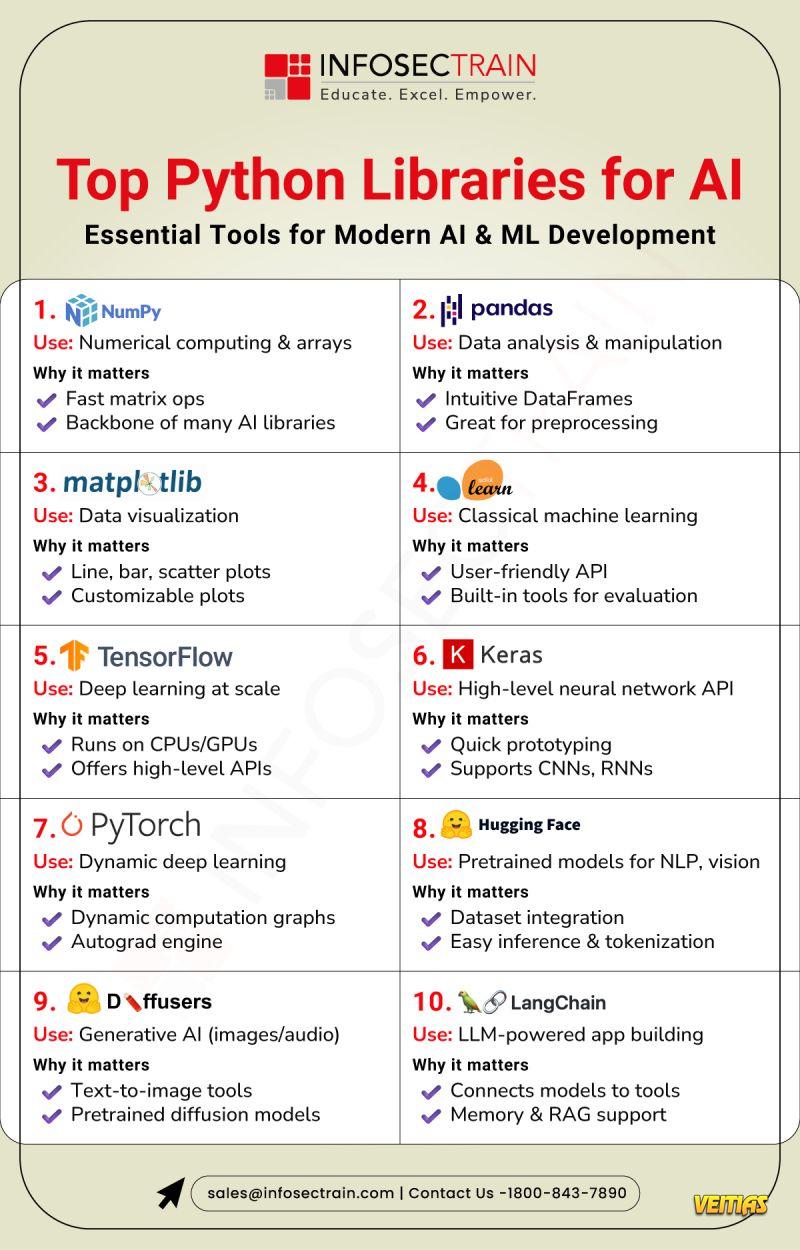Infosec Train 𝐅𝐫𝐞𝐞 𝐌𝐚𝐬𝐭𝐞𝐫𝐜𝐥𝐚𝐬𝐬: 𝐅𝐫𝐨𝐦 𝐅𝐢𝐫𝐬𝐭 𝐏𝐫𝐨𝐦𝐩𝐭 𝐭𝐨 𝐀𝐈 𝐏𝐨𝐰𝐞𝐫-𝐔𝐬𝐞𝐫
This masterclass transforms complete beginners into power-users armed with real-world AI workflows. If you want to work smarter, faster, and more creatively, this session is your gateway.
Date: 2 Dec 2025 (Tue)
Time: 08:00 – 09:00 PM (IST)
Speaker: Anas Hamid
𝐑𝐞𝐠𝐢𝐬𝐭𝐞𝐫 𝐅𝐑𝐄𝐄: https://www.infosectrain.com/events/chatgpt-masterclass-from-first-prompt-to-ai-power-user/
What You’ll Discover Inside This Masterclass
𝐂𝐡𝐚𝐭𝐆𝐏𝐓 𝐃𝐞𝐦𝐲𝐬𝐭𝐢𝐟𝐢𝐞𝐝
Understand what ChatGPT really is, what it can do for different industries, and why professionals everywhere are upgrading their AI literacy.
𝐈𝐧𝐬𝐢𝐝𝐞 𝐭𝐡𝐞 𝐌𝐢𝐧𝐝 𝐨𝐟 𝐆𝐏𝐓-𝟒𝐨
A simple breakdown of GPT-4o’s power—multimodal intelligence, instant responses, voice/vision capabilities, and how it “reasons.”
𝐓𝐡𝐞 𝐂.𝐑.𝐄.𝐀.𝐓.𝐄. 𝐏𝐫𝐨𝐦𝐩𝐭𝐢𝐧𝐠 𝐅𝐫𝐚𝐦𝐞𝐰𝐨𝐫𝐤
A practical, repeatable system to write prompts that deliver accurate, creative, and high-quality outputs every single time.
𝐒𝐥𝐚𝐬𝐡 𝐇𝐚𝐜𝐤𝐬 + 𝐇𝐢𝐝𝐝𝐞𝐧 𝐒𝐤𝐢𝐥𝐥𝐬
Quick shortcuts, smart prompt tricks, and powerful features most users never discover.
𝐏𝐫𝐨 𝐒𝐤𝐢𝐥𝐥: 𝐁𝐮𝐢𝐥𝐝 𝐘𝐨𝐮𝐫 𝐎𝐰𝐧 𝐂𝐮𝐬𝐭𝐨𝐦 𝐆𝐏𝐓
Learn how to craft a personalized AI assistant trained on your data, ready to automate recurring tasks and boost your daily productivity.
𝐖𝐨𝐫𝐤𝐟𝐥𝐨𝐰 𝐌𝐚𝐬𝐭𝐞𝐫𝐲
Use plugins, data analysis tools, and automation workflows to accelerate research, coding, documentation, reporting, and content creation.
𝐃𝐚𝐭𝐚, 𝐒𝐚𝐟𝐞𝐭𝐲 & 𝐏𝐫𝐢𝐯𝐚𝐜𝐲
How ChatGPT stores information, what it remembers, and how to manage your privacy like a pro.
𝐑𝐞𝐚𝐥 𝐒𝐤𝐢𝐥𝐥𝐬 𝐘𝐨𝐮’𝐥𝐥 𝐖𝐚𝐥𝐤 𝐀𝐰𝐚𝐲 𝐖𝐢𝐭𝐡
• Creative writing superpowers
• Smarter problem-solving
• Basic coding confidence
• AI-driven productivity & project management
𝐖𝐡𝐲 𝐘𝐨𝐮 𝐒𝐡𝐨𝐮𝐥𝐝 𝐀𝐭𝐭𝐞𝐧𝐝
Earn a CPE Certificate
Receive FREE mentorship & career guidance
Learn directly from AI & industry experts
#ChatGPTFreeMasterclass #AIPowerUser #AIForEveryone #FutureOfWork #LearnWithAI #PromptEngineering #GPT4o #AIEducation #DigitalSkills #TechTraining #Upskill2025 #infosectrain
This masterclass transforms complete beginners into power-users armed with real-world AI workflows. If you want to work smarter, faster, and more creatively, this session is your gateway.
Date: 2 Dec 2025 (Tue)
Time: 08:00 – 09:00 PM (IST)
Speaker: Anas Hamid
𝐑𝐞𝐠𝐢𝐬𝐭𝐞𝐫 𝐅𝐑𝐄𝐄: https://www.infosectrain.com/events/chatgpt-masterclass-from-first-prompt-to-ai-power-user/
What You’ll Discover Inside This Masterclass
𝐂𝐡𝐚𝐭𝐆𝐏𝐓 𝐃𝐞𝐦𝐲𝐬𝐭𝐢𝐟𝐢𝐞𝐝
Understand what ChatGPT really is, what it can do for different industries, and why professionals everywhere are upgrading their AI literacy.
𝐈𝐧𝐬𝐢𝐝𝐞 𝐭𝐡𝐞 𝐌𝐢𝐧𝐝 𝐨𝐟 𝐆𝐏𝐓-𝟒𝐨
A simple breakdown of GPT-4o’s power—multimodal intelligence, instant responses, voice/vision capabilities, and how it “reasons.”
𝐓𝐡𝐞 𝐂.𝐑.𝐄.𝐀.𝐓.𝐄. 𝐏𝐫𝐨𝐦𝐩𝐭𝐢𝐧𝐠 𝐅𝐫𝐚𝐦𝐞𝐰𝐨𝐫𝐤
A practical, repeatable system to write prompts that deliver accurate, creative, and high-quality outputs every single time.
𝐒𝐥𝐚𝐬𝐡 𝐇𝐚𝐜𝐤𝐬 + 𝐇𝐢𝐝𝐝𝐞𝐧 𝐒𝐤𝐢𝐥𝐥𝐬
Quick shortcuts, smart prompt tricks, and powerful features most users never discover.
𝐏𝐫𝐨 𝐒𝐤𝐢𝐥𝐥: 𝐁𝐮𝐢𝐥𝐝 𝐘𝐨𝐮𝐫 𝐎𝐰𝐧 𝐂𝐮𝐬𝐭𝐨𝐦 𝐆𝐏𝐓
Learn how to craft a personalized AI assistant trained on your data, ready to automate recurring tasks and boost your daily productivity.
𝐖𝐨𝐫𝐤𝐟𝐥𝐨𝐰 𝐌𝐚𝐬𝐭𝐞𝐫𝐲
Use plugins, data analysis tools, and automation workflows to accelerate research, coding, documentation, reporting, and content creation.
𝐃𝐚𝐭𝐚, 𝐒𝐚𝐟𝐞𝐭𝐲 & 𝐏𝐫𝐢𝐯𝐚𝐜𝐲
How ChatGPT stores information, what it remembers, and how to manage your privacy like a pro.
𝐑𝐞𝐚𝐥 𝐒𝐤𝐢𝐥𝐥𝐬 𝐘𝐨𝐮’𝐥𝐥 𝐖𝐚𝐥𝐤 𝐀𝐰𝐚𝐲 𝐖𝐢𝐭𝐡
• Creative writing superpowers
• Smarter problem-solving
• Basic coding confidence
• AI-driven productivity & project management
𝐖𝐡𝐲 𝐘𝐨𝐮 𝐒𝐡𝐨𝐮𝐥𝐝 𝐀𝐭𝐭𝐞𝐧𝐝
Earn a CPE Certificate
Receive FREE mentorship & career guidance
Learn directly from AI & industry experts
#ChatGPTFreeMasterclass #AIPowerUser #AIForEveryone #FutureOfWork #LearnWithAI #PromptEngineering #GPT4o #AIEducation #DigitalSkills #TechTraining #Upskill2025 #infosectrain
Infosec Train 𝐅𝐫𝐞𝐞 𝐌𝐚𝐬𝐭𝐞𝐫𝐜𝐥𝐚𝐬𝐬: 𝐅𝐫𝐨𝐦 𝐅𝐢𝐫𝐬𝐭 𝐏𝐫𝐨𝐦𝐩𝐭 𝐭𝐨 𝐀𝐈 𝐏𝐨𝐰𝐞𝐫-𝐔𝐬𝐞𝐫
This masterclass transforms complete beginners into power-users armed with real-world AI workflows. If you want to work smarter, faster, and more creatively, this session is your gateway.
📅 Date: 2 Dec 2025 (Tue)
⌚ Time: 08:00 – 09:00 PM (IST)
🎤 Speaker: Anas Hamid
🔗 𝐑𝐞𝐠𝐢𝐬𝐭𝐞𝐫 𝐅𝐑𝐄𝐄: https://www.infosectrain.com/events/chatgpt-masterclass-from-first-prompt-to-ai-power-user/
➡️ What You’ll Discover Inside This Masterclass
✅ 𝐂𝐡𝐚𝐭𝐆𝐏𝐓 𝐃𝐞𝐦𝐲𝐬𝐭𝐢𝐟𝐢𝐞𝐝
Understand what ChatGPT really is, what it can do for different industries, and why professionals everywhere are upgrading their AI literacy.
✅𝐈𝐧𝐬𝐢𝐝𝐞 𝐭𝐡𝐞 𝐌𝐢𝐧𝐝 𝐨𝐟 𝐆𝐏𝐓-𝟒𝐨
A simple breakdown of GPT-4o’s power—multimodal intelligence, instant responses, voice/vision capabilities, and how it “reasons.”
✅𝐓𝐡𝐞 𝐂.𝐑.𝐄.𝐀.𝐓.𝐄. 𝐏𝐫𝐨𝐦𝐩𝐭𝐢𝐧𝐠 𝐅𝐫𝐚𝐦𝐞𝐰𝐨𝐫𝐤
A practical, repeatable system to write prompts that deliver accurate, creative, and high-quality outputs every single time.
✅𝐒𝐥𝐚𝐬𝐡 𝐇𝐚𝐜𝐤𝐬 + 𝐇𝐢𝐝𝐝𝐞𝐧 𝐒𝐤𝐢𝐥𝐥𝐬
Quick shortcuts, smart prompt tricks, and powerful features most users never discover.
✅𝐏𝐫𝐨 𝐒𝐤𝐢𝐥𝐥: 𝐁𝐮𝐢𝐥𝐝 𝐘𝐨𝐮𝐫 𝐎𝐰𝐧 𝐂𝐮𝐬𝐭𝐨𝐦 𝐆𝐏𝐓
Learn how to craft a personalized AI assistant trained on your data, ready to automate recurring tasks and boost your daily productivity.
✅𝐖𝐨𝐫𝐤𝐟𝐥𝐨𝐰 𝐌𝐚𝐬𝐭𝐞𝐫𝐲
Use plugins, data analysis tools, and automation workflows to accelerate research, coding, documentation, reporting, and content creation.
✅𝐃𝐚𝐭𝐚, 𝐒𝐚𝐟𝐞𝐭𝐲 & 𝐏𝐫𝐢𝐯𝐚𝐜𝐲
How ChatGPT stores information, what it remembers, and how to manage your privacy like a pro.
➡️ 𝐑𝐞𝐚𝐥 𝐒𝐤𝐢𝐥𝐥𝐬 𝐘𝐨𝐮’𝐥𝐥 𝐖𝐚𝐥𝐤 𝐀𝐰𝐚𝐲 𝐖𝐢𝐭𝐡
• Creative writing superpowers
• Smarter problem-solving
• Basic coding confidence
• AI-driven productivity & project management
➡️ 𝐖𝐡𝐲 𝐘𝐨𝐮 𝐒𝐡𝐨𝐮𝐥𝐝 𝐀𝐭𝐭𝐞𝐧𝐝
✔️ Earn a CPE Certificate
✔️ Receive FREE mentorship & career guidance
✔️ Learn directly from AI & industry experts
#ChatGPTFreeMasterclass #AIPowerUser #AIForEveryone #FutureOfWork #LearnWithAI #PromptEngineering #GPT4o #AIEducation #DigitalSkills #TechTraining #Upskill2025 #infosectrain
0 التعليقات
0 المشاركات
1153 مشاهدة
0 معاينة







